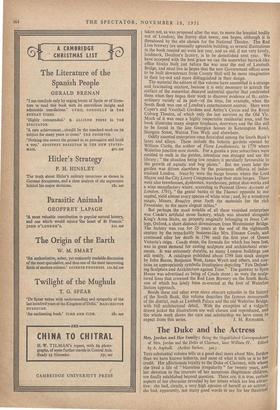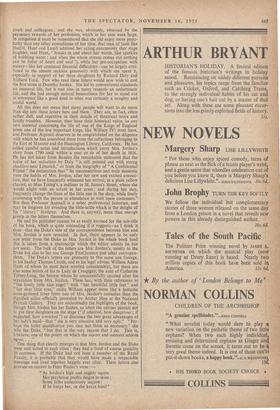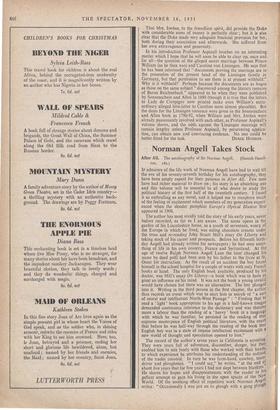The Duke and the Actress
Mrs, Jordan and Her Family: Being the Unpublished Correspondence of Mrs. Jordan and the Duke of Clarence, later William IV. Edited by A. Aspinall. (Arthur Barker. 3os.) THIS substantial volume tells us a good deal more about Mrs. Jordan than we have known hitherto, and most of what it tells us is to her credit. Her affectionate loyalty to the Duke of Clarence, with whonl, she lived a life of "blameless irregularity" for twenty years, and her devotion to the interests of her numerous illegitimate children, are finally established beyond question. There are, it is true, certain aspects of her character revealed by her letters which are less attrac- tive: she had, clearly, a very high opinion of herself as an actress, she had, apparently, not many good words to say for her theatrical rivals and colleagues ; and she was, obviously, obsessed by the pecuniary rewards of her profession, which in her case were large. In mitigation it must be remembered that she did enjoy more popu- larity than any other comedienne of her time, that men of taste like Hazlitt, Hunt and Lamb admired her acting .enormously (her stage laughter, said Hunt, "breaks in and about her words, like sparkles oi bubbling water and when the whole stream comes out nothing can be fuller of heart and soul "), while her pre-occupation with money—like her continual financial difficulties—can be largely attri- buted to the almost reckless generosity with which she spent it, especially in support of her three daughters by Richard Daly and Richard Ford. Few who read these letters would now wish to cast the first stone at Dorothy Jordan. She led by conventional standards an immoral life, but it was also in many respects an unfortunate life, and she had enough natural benevolence for her to stand out in retrospect like a good deed in what was certainly a naughty and sordid world.
All this does not mean that many people will want to do more than dip into these letters here and there. They are, in fact, often rather dull, and repetitive in their details of theatrical tours and iamily troubles. However, they have their historical value, as any new material concerning the life of one of the Kings of England (even one of the less important kings, like William IV) must have, and Professor Aspinall deserves to be congratulated on the diligence with which he has assembled them from the collections belonging to the Earl of Munster and the Huntington Library, California. He has added careful notes and introductions which carry Mrs. Jordan's story from 1790 until within a year or so of her death in 1816. He has not taken from Boaden the remarkable statement that the scene of her seduction by Daly "is still pointed out with strong shudders near Limerick," or from the biography of "A Confidential Friend!' the declaration that "So unostentatious and truly domestic were the habits Of Mrs. Jordan, after her new and exalted connec- tion, that we have frequently witnessed her arrival, in a plain yellow chariot, at Miss Tuting's, a milliner in St. James's Street, where she would alight with an infant in her arms ; and during her stay, frequently change the linen of the little one in the shop, while freely conversing with the person in attendance to wait upon customers." But then Professor Aspinall is a sober professional historian, and may be forgiven for avoiding the tittle-tattle which is the delight of his " literary " brethren. And there is, anyway, more than enough gossip in the letters themselves.
He and his publisher cannot be as easily excused for the sub-title of his book, which is quite misleading if it suggests—Las I think it does—that the Duke's side of the correspondence between him and Mrs. Jordan is now revealed. In fact, there appears to be only one letter from the Duke to Mrs. Jordan in the whole book (and this is taken from a manuscript which the editor admits he has not seen). The bulk of the letters are Mrs. Jordan's, mostly to the Duke but also to her son George FitzClarence and other correspon- dents. The Duke's letters are primarily to this same son George, to his banker Thomas Coutts, and to his legal adviser William Adam (both of whom he must have worried considerably), but there are also some letters of his to Lady de Crespigny, the aunt of Catherine Tylney-Long, the heiress whom he unsuccessfully courted after his separation from Mrs. Jordan. These last, with their references to "the lovely little nice angel" with "her beautiful little feet" and "her dear little eyes," make William appear more like a fantastic cross-gartered lover from one of Mrs. Jordan's comedies than the dignified sailor officially presented by Archer Shee at the National Portrait Gallery. They are undoubtedly the highlights of the' book, though Mrs: Jordan has her flashes, as when she advises parents not to put their daughters on the stage (" if admired, how dangerous ; if neglected, how wretched ") or discusses the two great advantages of her lady's maid—that "she is very attentive arid very ugly." "Per- haps the latter qualification you may not think so necessary," she tells the Duke, "but that is the very reason that I do. This is, I, believe, one of the points on which the master and mistress seldom agree. . • ."
One thing that clearly emerges is that Mrs. Jordan and the Duke were well suited to each other ; they had a fund of coarse geniality in common. If the Duke had not been a member of the Royal Family, it is probable that they would have made a respectable marriage and lived together happily ever, after. These letters also Provide an answer to Peter Pindar's verse:— " As Jordan's high and mighty squire Her playhouse profits deigns to skim ; Some folks audaciously inquire: If he keeps her, or she keeps him?"
That Mrs. Jordan, in the friendliest spirit, did provide the Duke with considerable sums of money is perfectly clear ; but it is also clear that the Duke made very adequate financial provision for her both during their association and afterwards. She suffered front her own extravagance and generosity.
In his introduction Professor Aspinall touches on an interesting matter which I hope that he will soon be able to clear up, once and for all—the question of the qlleged secret marriage between Prince William (as he then was) and Caroline von Linsingen. He says that he has been informed that "documents proving the marriage are in the possession of the present head of the Linsingen family in Germany, but that permission to see them is at present withheld." Why is it withheld? Perhaps because the documents are as bogus as those on the same subject "discovered among the literary remains of Baron Reichenbach " appeared to be when they were published by Sonnenschein and Allen in 1880 (though it is true that the letter to Lady de Crespigny now printed make even William's extra- ordinary alleged love-letter to Caroline seem almost plausible). But the dates for the Linsingen romance were given in the Sonnenschei and Allen book as 1790-92, when William and Mrs. Jordan were already passionately involved with each other, as Professor Aspinall's, volume shows, and the odds against the 'Linsingen marriage will remain lengthy unless Professor Aspinall, by persevering applica- tion, can obtain new and convincing evidence. No one could be
















































































 Previous page
Previous page